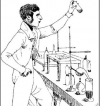O’Shaughnessy and O’Shaughnessy’s
By Fred Gardner
Tod Mikuriya, MD, a Berkeley-based psychiatrist, essentially invented the specialty now known as “Cannabis clinician” and the field of Cannabis-based medicine. When Tod died in 2007, Philip A. Denney, MD, said, “Tod was the mentor of every doctor working in the field. ”
Tod was involved in every aspect of the medical marijuana movement: as a physician treating patients, a historian recovering the pre-prohibition literature, a researcher documenting the astonishing range of conditions that people were treating with cannabis, an organizer (founder of the Society of Cannabis Clinicians), an engaged citizen intent on implementing the law (California’s “Compassionate Use Act,” which he had helped draft), and an educator sharing his singular knowledge with patients, colleagues, and thecommunity at large.
As more doctors began monitoring cannabis use by patients, Tod saw the need for a journal in which they could share findings and observations and be kept abreast of relevant scientific and political developments. That’s where I came in. Tod and I were close friends and my resume included stints on the editorial board at Scientific American and as public information officer for the District Attorney of San Francisco. We brought out our first issue in the Summer of 2003 and named it after William Brooke O’Shaughnessy, MD, who Tod called “a personal hero.”
 In 1839 young Dr. O’Shaughnessy had presented a paper at the Medical College of Calcutta, describing cases in which Indian doctors used hemp (alcohol extracts) to successfully treat rheumatism, hydrophobia, cholera, tetanus, and epilepsy. The paper was published in the Transactions of the Medical and Physical Society of Bengal, 1838-1840. A version in the Provincial Medical Journal in 1843 introduced European physicians to the idea that Cannabis yielded a useful medicine. “In hemp,” O’Shaughnessy advised, “the profession has gained an anti-convulsive remedy of the greatest value.” (See The Remarkable W.B. O’Shaughnessy by Dr. Michael Aldrich.)
In 1839 young Dr. O’Shaughnessy had presented a paper at the Medical College of Calcutta, describing cases in which Indian doctors used hemp (alcohol extracts) to successfully treat rheumatism, hydrophobia, cholera, tetanus, and epilepsy. The paper was published in the Transactions of the Medical and Physical Society of Bengal, 1838-1840. A version in the Provincial Medical Journal in 1843 introduced European physicians to the idea that Cannabis yielded a useful medicine. “In hemp,” O’Shaughnessy advised, “the profession has gained an anti-convulsive remedy of the greatest value.” (See The Remarkable W.B. O’Shaughnessy by Dr. Michael Aldrich.)
Cannabis-based medicines were produced, used, and written about in medical journals with increasing frequency, especially in the U.S., throughout the second half of the 19th century and into the 20th.
Although it was well established that cannabis ameliorated the symptoms of a wide range of conditions, the pharmaceutical manufacturers did not know how to produce a consistent cannabis-based medicine. This how the U.S. Dispensatory of 1926 described the frustrating situation:
“Cannabis is used in medicine to relieve pain, to encourage sleep, and to soothe restlessness… Because of the great variability in the potency of different samples of cannabis it is well nigh impossible to approximate the proper dose of any individual sample except by clinical trial. Because of occasional unpleasant symptoms from unusually potent preparations, physicians have generally been overcautious in the quantities administered.”
Simply put, doctors were reluctant to prescribe cannabis tinctures (the prevailing delivery system) because they might be too weak or too strong. That is why physicians and pharmacists —and the American people—did not strongly resist the federal Prohibition of marijuana in 1937.
Prohibited History
Prohibition applied not just to the herb itself —the “devil weed”— but to everything the medical profession knew about it. Harry Anslinger, the Drug Czar of his time (1931 to 1962), not only spread disinformation about cannabis, he suppressed reports by the New York Academy of Medicine and sociologist Alfred Lindesmith that documented its medical usefulness.
When millions of students, soldiers and other young Americans discovered marijuana in the mid-1960s, almost none of us knew anything about its history as medicine. “It wasn’t just marijuana that got prohibited,” Tod used to say, “it was the truth about history.”
In the early 1960s, after completing a residency in psychiatry, Tod was employed briefly by the National Institute of Mental Health in Washington, DC. He set about photocopying all the pre-Prohibition literature on cannabis that he could find in the National Library of Medicine archives. In 1973 he self-published an anthology, Marijuana Medical Papers, that led off with W.B. O’Shaughnessy’s landmark paper.
Tod had by then moved to Berkeley, California and was in private practice. On the wall of his office hung a framed line drawing of O’Shaughnessy in a laboratory, looking very dapper and mod as he holds up a beaker to study its contents.
Throughout the 1970s and ’80s Tod took part in political challenges to marijuana prohibition. The breakthrough came in 1996, when Californians voted “yes” on Proposition 215. It authorized physicians to approve “the use of marijuana in the treatment of cancer, anorexia, AIDS, chronic pain, spasticity, glaucoma, arthritis, migraine, or any other illness for which marijuana provides relief.”
Tod had interviewed some 200 members of the San Francisco Cannabis Buyers Club who were using marijuana to treat all the conditions for which it had once been legally prescribed —and then some, including AIDS. “Patients have more to teach doctors about Cannabis use than vice versa,” Tod often said.
O’Shaughnessy’s was just a placeholder name until we could think of something better, but every suggestion seemed too portentous in connection with an unorthodox specialty involving a quasi-legal herb. We decided to go with O’Shaughnessy’s after a lawyer admonished us, “You must not name it that. People will think it’s an Irish bar.”
Tod died in May, 2007. The SCC has abided under the leadership of Jeffrey Hergenrather, MD. O’Shaughnessy’s abides on this site and as a tabloid published when we have something to say and can pay the printer. O’S is distributed by SCC members and some enlightened dispensaries.


